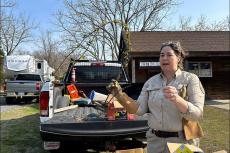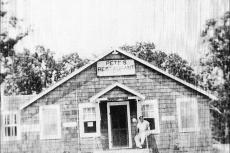Update, July 1, 10:30 a.m.: East Hampton Town is seeking to stop expansion of a sand mine on Middle Highway in East Hampton.
The town board has directed an outside law firm to commence legal proceedings against the New York State Department of Environmental Conservation and/or Sand Highway L.L.C., seeking annulment of the former's amended permit, issued March 30, allowing excavation below the groundwater table at Middle Highway, East Hampton, and creation of an approximately six-acre pond there.
The board voted unanimously and without additional comment at the conclusion of its June 18 meeting.
The sand mine is owned by Patrick Bistrian Jr., who proposes digging the pond, to a depth of 110 feet below the groundwater table, in order to continue mining sand and gravel. The D.E.C. determined last year that expansion of the pit would not have a significant negative impact on its surroundings, despite the strong objections of the town board, the Group for the East End, the Suffolk County Water Authority, Assemblyman Fred W. Thiele Jr., and a coalition of about 250 residents.
The board's June 18 resolution noted that the site is in a residential zone, where mining uses are prohibited, although under town code the operation is classified as a pre-existing, nonconforming facility. The lawsuit will seek to enjoin Sand Highway from commencing and/or continuing any activities authorized under the amended D.E.C. permit, on the grounds that such activities violate the town's zoning code, which prohibits the expansion of, or change to, prior nonconforming uses.
Suffolk County's population of more than one million, the complaint notes, "draws its drinking supply from a sole-source aquifer. The property itself is uniquely located in a special groundwater protection area within Suffolk County that is critical to the region's water supply, and is designated as such to protect the sole-source aquifer and the County's groundwater resources."
Town Supervisor Peter Van Scoyoc said in an accompanying affidavit that "The creation of a lake or 'water-hole' would be an attractive nuisance and raises serious safety concerns for the children who are likely to trespass onto the site both during the mining operation and after the site is revegetated. Such trespass has occurred in the past and is expected to occur in the future."
The town board opposed the expansion of the mine in multiple letters to the D.E.C. last year. "Members of the town board adamantly oppose this application, as it would not only be an environmental cataclysmic intrusion into the water table that serves as a sole-source aquifer for the entire South Fork, but is patently prohibited by the zoning code of the Town of East Hampton and thus such application must be denied by the D.E.C.," the board wrote.
The county water authority wrote to the D.E.C. that sand, gravel, and clay comprise a natural form of pollution prevention and filtering of groundwater and drinking water. "When materials that make up this barrier are removed, the protection of the aquifer is reduced or lost altogether," wrote Jeffrey W. Szabo, chief executive officer of the authority, which has two public supply pump stations near one of the Bistrian family's mines.
"The D.E.C. has been nothing but a rubber stamp for the mining industry for years," Mr. Thiele told The Star last year. "That's what happened at Sand Land,Ó a mine in Noyac, Òand that's what's happening here. I would say they stick their head in the sand, but there isn't any sand for them to stick their head in."
An email from the D.E.C. on Monday repeated previous statements detailing its review process. "The modification does not authorize horizontal expansion of the mine site, increase the rate of extraction, or allow the importation of off-site material," it said. The D.E.C. added conditions to the modified permit to protect the environment and ensure public safety, the statement added, and requires the mine's operator to plant "appropriate aquatic plants in the pond's shelf area to enhance habitat development."
The mine is required to sample six onsite monitoring wells quarterly when mining activities reach groundwater, according to the D.E.C., which must be analyzed by a certified laboratory for total and dissolved metals, volatile organic compounds, and semi-volatile organic compounds. Sand Highway L.L.C. must provide results to the D.E.C.
The D.E.C. "cannot comment further due to litigation," the email said.
A July 2019 inspection of the mine showed it toÊbe in compliance with its permitted length-of-mine timeline, as well as its mining area. It also complied with town code setbacks, dust and noise control rules, screening requirements, and other stipulations.
Mr. Bistrian did not return a call seeking comment.
With Reporting by Christine Sampson
--
Note: This story has been updated since it was originally published online.



